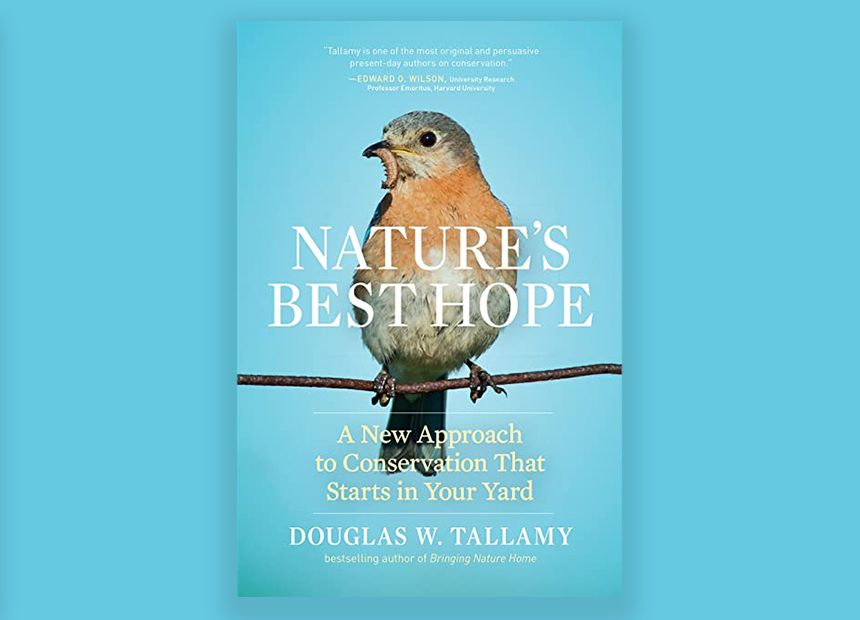By Maureen Draper
The war on insects is not one we want to win, as Douglas W. Tallamy writes in his new book, Nature’s Best Hope: A New Approach to Conservation That Starts in Your Yard. I’ve been in the Green Foothills community for many years and thought other members of this wonderful community would enjoy key learnings from his book.
Insects are essential pollinators of 87.5 percent of all plants and 90 percent of all flowering plants. Just as important, birds depend on insects. Baby birds must be fed insects, and in great numbers. It takes hundreds of trips a day, depending on the species, to bring food to nestlings.
With 85% of the earth’s land in private hands we cannot depend on permanently protected land to sustain biodiversity. One of the best actions we can take as individuals is to fill our gardens with plants that host the greatest number of insects. This means growing at least some of the native plants that have co-evolved over millennia with the insects that have developed the necessary enzymes to tolerate the protective chemical toxins that defend plants from hungry predators.
If you’re like me, you’ve introduced plants you may have loved as a child or admired in a friend’s garden. They may be beautiful but we have the obligation to ask ourselves if they serve the health of the garden and of the local ecosystem. I was surprised and disappointed to learn that the butterfly bush (buddleja) in my garden supports the larval development in only one of the seven hundred twenty-five butterfly species.
The fact is that 90% of all plant-eating insects are specialized, locked into dependency on one plant for egg-laying—such as the monarch butterfly’s need for milkweed. This is the problem with introduced, non-native plants. They don’t support local insects; they lack the predators that keep them in check in their native habitat and so have a tendency to take over an area–as Russian thistle (tumbleweed), cheatgrass, eucalyptus, kudzu, common reed, various brooms, and countless other species have done.
If you’re not in a position to plant a tree, you can try to make room for at least a few natives such as coyote bush (Baccharis Pilularus), which supports between eleven and eighteen butterflies and moths, and is also relatively fire resistant. Goldenrod (Solidago) supports a staggering thirty-nine.
“If insects were to vanish,” said E. O. Wilson, “the environment would collapse into chaos.” We can make a significant contribution to birdlife and the general health of the ecosystem around us by making life easier for one insect in particular: caterpillars.
Caterpillars are the mainstay of most birds in North America. Why? It comes down to size (it takes 200 aphids to equal the weight of a medium-sized caterpillar) and structure: their soft bodies can be stuffed directly down the throats of nestlings. The best host for caterpillars? Native oaks (Quercus) can support over 500 species of caterpillar as well as provide food and shelter for about two dozen species of birds, including scrub jays, magpies, wood ducks, wild turkeys, mountain quail, flickers, and acorn woodpeckers. Willows (Salix) and cherry (Prunus) can also serve as great hosts.
It’s helpful to leave the oak leaf litter as a mulch and nursery, as it may provide a place to spin and shelter a cocoon. And caterpillars aren’t the only insects that feed on leaves, twigs, acorns, bark and wood of oak trees. Lignin-rich oak leaves are excellent habitat for hundreds of species of nematodes, arthropods, and other invertebrates that break down organic material so that it can nourish further growth. Nature poet Mary Oliver said that the year she didn’t clean up her garden the birds were the most happy and abundant.
For more information see www.calscape.org or https://www.nwf.org/NativePlantFinder for lists of native plants and trees according to zip code, as well as the butterflies they host.
Maureen Draper and her husband Paul are long time members of the Green Foothills community. She is an accomplished musician and author.


Leave a Reply